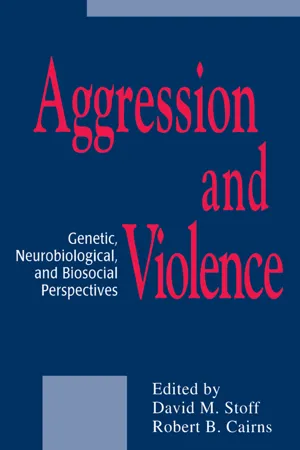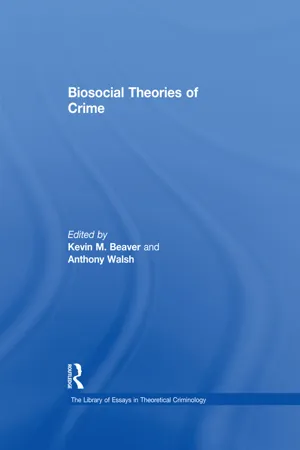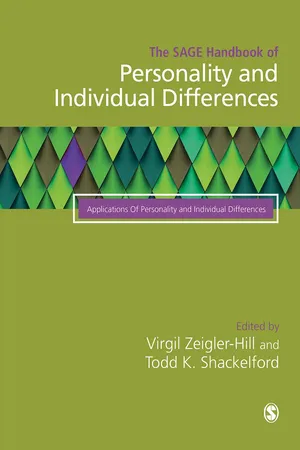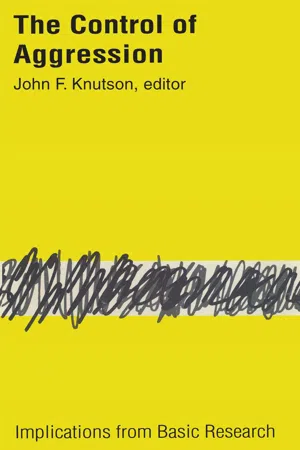Psychology
Genetics of Aggression
The genetics of aggression refers to the study of how genetic factors influence aggressive behavior. Research in this area explores the role of specific genes and genetic variations in predisposing individuals to aggressive tendencies. By examining the genetic underpinnings of aggression, scientists aim to better understand the complex interplay between genetic and environmental influences on aggressive behavior.
Written by Perlego with AI-assistance
Related key terms
8 Key excerpts on "Genetics of Aggression"
- eBook - ePub
Aggression and Violence
Genetic, Neurobiological, and Biosocial Perspectives
- David M. Stoff, Robert B. Cairns(Authors)
- 2014(Publication Date)
- Psychology Press(Publisher)
aggression is therefore not a phenotype for genetic analysis. Narrower or better-defined categories of aggression can be utilized; much of the relevant work on aggression is on neuropsychological phenotypes and psychiatric diagnoses, which are associated with forms of aggression but which represent goals in their own right. A full appreciation of the genetic antecedents of aggression would require a better understanding of what aggression is, as well as the identification of genetic and nongenetic origins of interindividual differences in a wide variety of behaviors. Changing the definition of aggressive behavior will obviously change the genes involved.Both within and outside the laboratory, pharmacological manipulations of neurochemical systems moderate and augment impulsive and aggressive behaviors. By manipulating serotonin, particular murine-aggressive behaviors can be augmented or reduced. Androgen levels also play a role in determining aggressiveness, for example, rough-and-tumble play (Levine, 1966 ; see also Gariépy, Lewis, and Cairns, chap. 3 , this volume). In humans, aggressive behavior is frequently released only when the individual is intoxicated. These interactions between aggression and drugs resemble gene–environment interactions in behavior. More importantly, for the purpose of discovering the determinants of aggression, results from behavioral pharmacology may also serve to identify the neurochemical pathways where genetic variants alter individual variation in the predisposition to such behaviors.Functionally variant alleles cause heritable behavioral variation in impulsiveness and aggressivity. In animals, the behavioral variation resulting from the differential action of these alleles is exemplified by behavioral differences between species and between strains of animals (Plomin, 1990 - eBook - ePub
The Social Psychology of Aggression
3rd Edition
- Barbara Krahé(Author)
- 2020(Publication Date)
- Routledge(Publisher)
With regard to the question of whether or not aggression is an inevitable part of human nature and individual character, research showing the impact of genetic factors has sometimes been construed as suggesting a deterministic, and thus pessimistic, view – if individuals carry the aggressive genes, they will grow up to be aggressive. However, such a view is rejected by behaviour geneticists. They stress that individuals’ genetic make-up may predispose them towards becoming an aggressive person, but environmental factors play a crucial role in determining whether or not that predisposition will actually be expressed in aggressive behaviour. As noted by Van Goozen, Fairchild, Snoek, and Harold (2007), a genetic disposition towards aggressive behaviour may become manifested in behaviour in a negative family environment, or it may be suppressed in a positive environment. As children inherit the genetic disposition towards aggression from their parents, they are likely to grow up in a more aggression-prone family environment (Moffitt, 1993). To complicate matters further, children with a genetic disposition towards aggression may elicit negative responses from their social environment through their aggressive behaviour, also pointing to the interactive influences of nature and nurture.The critical role of environmental factors is also demonstrated by evidence from the field of epigenetics . This research has shown that adverse experiences affecting individuals at sensitive periods of life, especially in prenatal development and early infancy, may trigger changes in the function of genes that lead to cognitive and emotional deficits involved in aggressive behaviour (Palumbo, Mariotti, Iofrida, & Pellegrini, 2018; Waltes et al., 2016). These findings show that genetic (inherited) and environmental (acquired) factors mutually influence each other, which may explain why individual differences in aggressive behaviour are highly stable over time. We will return to the issue of stability in more detail in Chapter 4 .epigenetics: field of study showing that adverse experiences may change a person’s genes related to aggressive behaviour.H ormones and aggression
hormones: higher levels of testosterone and lower levels of cortisol have been linked to aggression, but they need to be considered in combination with environmental influences.Another line of biological research on aggression is concerned with the role of hormonal and other physiological processes in explaining variations in aggressive behaviour (Archer & Carré, 2017; Van Goozen, 2005). An obvious candidate for examination is the male sex hormone testosterone, both to account for individual differences among men in their aggressive tendencies, and to explain the widely demonstrated gender differences in physical aggression (see Chapter 4 - eBook - ePub
Social Psychology in Christian Perspective
Exploring the Human Condition
- Angela M. Sabates(Author)
- 2012(Publication Date)
- IVP Academic(Publisher)
Parens (2004), for example, notes some significant obstacles for behavioral genetic research. First, suppose researchers find that identical twins (exact genetic match) are more similar on some trait than are fraternal twins. In this case we might have a greater confidence that genes are involved, but these findings do not yet reveal anything regarding which genes are involved and in what ways. Second, suppose a researcher were interested in evaluating the relative effects of genes and environment and compared identical twins raised together with those raised apart for a particular aspect of aggression. The results often will not be informative since, as most of the research suggests, identical twins are likely to be adopted into quite similar environments, which negates the environmental factor. Thus, it appears that with respect to genetic influences on aggressive behavior, we are nowhere near finding a “criminal gene.” Instead, it is more accurate to suggest that some individuals appear to be especially vulnerable to the ill effects of negative environments and may be more inclined toward antisocial behavior, including aggression. The exact mechanisms that explain the complex interplay between genetic/physiological and environmental influences are far from being determined. Additionally, the research to date does not support the notion that people with “vulnerable genes” have no choice regarding aggression. Indeed, as Parens (2004) notes, to say that something is influenced by genetics is not the same thing as saying that it is unchangeable. A brief comment on biological explanations of aggression. As noted in the literature just discussed, there have been many advances in isolating specific brain structures and neurochemical processes, as well as possible genetic contributions to aggressive behavior. Several words of caution are needed, though. Keep in mind that much of this research has conflicting results - eBook - ePub
An Introduction to Social Psychology
Global Perspectives
- James Alcock, Stan Sadava(Authors)
- 2014(Publication Date)
- SAGE Publications Ltd(Publisher)
In sum, although the debate over evolutionary psychology continues, because of its problems of testability, its tendency to ignore evidence that does not fit with the genetic model, and the small effect sizes it claims relative to the much larger effects due to psychosocial variables, it is wise at present to remain cautious with regard to its claims. Nonetheless, we must not forget that despite the controversy about some of the particular claims put forward by evolutionary psychologists, we are indeed the products of evolution. As is discussed below, genetically determined brain mechanisms are likely to influence at least some of our aggressive tendencies, even though, because of genetic variation, the propensity for such behaviour is likely to vary from individual to individual.Key Point:
Although evolutionary processes have shaped our brains and nervous systems, arguments that human aggression has evolved through natural selection remain at best controversial.Genetic roots
Regardless of whether there are genes that relate directly to aggression, the interaction between genes and environment certainly plays a significant role in whether children grow up to be more or less aggressive. Even at birth, there are clear differences in temperament, which is defined in terms of how excitable an infant is, combined with the ability to calm down (Jong et al., 2010; Rothbart, Ahadi & Evans, 2000). Bang some cymbals together in a hospital nursery and all the children will cry, but some will soon stop and others will cry for what seems to be ages. This reaction presumably reflects inborn differences in their autonomic nervous systems, and these differences, in interaction with environmental factors, can lead to quite different reactions to threat or provocation later on in life.Some particular genes appear especially important to an understanding of aggressive and antisocial behaviour. For example, Caspi et al. (2002) followed a sample of male children from birth to adulthood in the attempt to understand why some children who are maltreated during childhood develop antisocial behaviour and others do not. Although parental maltreatment often leads to aggressive and antisocial behaviour in children, they found evidence that children with a particular genotype (related to the gene MAOA, which encodes an enzyme that makes some particular neurotransmitters inactive) were less likely to develop such problems despite parental maltreatment. They concluded that particular genotypes can render children less sensitive to the effects of harsh treatment. - eBook - ePub
- KevinM. Beaver(Author)
- 2017(Publication Date)
- Routledge(Publisher)
Table 1 summarizes the text. The research designs covered here are not intended to be exhaustive but are intended to illustrate what kinds of studies can be done using the logic of behavioral-genetic methods.Question 1: Is Children’s Aggression Wholly Accounted for by Genetic Factors, or Does It Have Nongenetic Causes as Well?
More than 100 studies have addressed the question of genetic influence on antisocial behavior (Moffitt, in press), and metaanalyses conclude that genes influence 40% to 50% of population variation in antisocial behavior (Miles & Carey, 1997; Rhee & Waldman, 2002). This research unequivocally proves that environmental influences account for variation. This fact constitutes a remarkable contribution to the understanding of causation (Plomin, 1994). In addition, it is recognized that the heritability coefficient indexes not only the direct effects of genes but also the effects of interactions between genes and family-wide environments (Boomsma & Martin, 2002; Rutter & Silberg, 2002). In such interactions, the effect of an environmental risk may be even larger than previously reported among the subgroup of individuals having a vulnerable genotype. This is the case for antisocial behaviors.One useful feature of behavioral-genetic research designs is that they offer two powerful methods for documenting the importance of environmental effects (Plomin, DeFries, McClearn, & McGuffin, 2001). One of these methods of detecting environmental influence tests whether any of the family members in a study sample are more similar than can be explained by the proportion of genes they share. For instance, monozygotic (MZ) twins’ genetic similarity is twice that of dizygotic (DZ) twins and, therefore, if nothing but genes influenced antisocial behavior, MZ twins’ behavior ought to be at least twice as similar as that of DZ twins. If that is not the case, then it can be assumed that something environmental has influenced the twins and enhanced their similarity. For almost all human behavioral traits studied thus far, environmental factors shared by family members (variously labeled the “family-wide,” “common,” or “shared” environment) have not been found to make family members similar (Rowe, 1994). Antisocial behavior is a marked exception. A comparison of shared environment effects across 10 psychiatric disorders revealed that such effects were stronger for antisocial personality and conduct disorder than for affective, anxiety, or substance disorders (Ken-dler, Prescott, Myers, & Neale, 2003). - eBook - ePub
The SAGE Handbook of Personality and Individual Differences
Volume III: Applications of Personality and Individual Differences
- Virgil Zeigler-Hill, Todd K. Shackelford(Authors)
- 2018(Publication Date)
- SAGE Publications Ltd(Publisher)
Central to the GAM is prior research about factors within a person that predispose them to aggression – individual differences in traits, genetics, biology, and learned experience that make one person more likely than another to behave aggressively. Because the GAM is a model of the processes that leads to an individual behaving aggressively in the moment, it also describes the underlying biological, neurocognitive, social, and other psychological factors and processes that may influence an episode of aggression. It also incorporates outcomes of the aggressive event, that is, the learnings that feed back into the person's stable psychological makeup, learnings that change the person's expectations and beliefs about how well or poorly future aggressive (or non-aggressive) behaviors will work. Of course, individual differences in the predisposition to aggress can never fully explain aggressive behavior. Environmental factors that trigger aggressive tendencies are also important factors in the aggression equation, and are prominent in the GAM as well.We begin this chapter by characterizing aggression, by describing historical and modern theories of aggressive behavior, and then by explaining the GAM, which draws together many of these theories. Key research methodologies and findings relevant to aggressive behavior are outlined, along with issues around the development of aggressive behavior and the challenges involved in treating the aggressive individual. In terms of the wider social implications of aggression research, we argue for a truly evidence-based approach to managing societal aggression and note directions for future research.Characteristics of Aggression
Definitions
Defining aggression is far from straightforward because there are several key issues that need to be taken into account. Historically, it has been difficult to compare research findings and theories related to aggressive behavior because aggression has been defined and operationalized differently both within and between scientific disciplines. More recently, aggression researchers from psychology have converged on an approach that is broadly inclusive of a range of behaviors that involve one person harming another and is exemplified in the widely used definition of Anderson and Bushman (2002): aggression is any behavior enacted with the intention to harm another person who is motivated to avoid that harm. This definition is broad enough to capture a wide range of aggressive behaviors, while also excluding activities that can ‘hurt’ a target person but to which the target of the hurt willingly consents (e.g., undergoing surgery). - eBook - ePub
Control of Aggression
Implications from Basic Research
- Stanton Wheeler(Author)
- 2017(Publication Date)
- Routledge(Publisher)
3Genetics and Mouse Aggression G. E. Mcclearn and J. C. DefriesGerald McClearn completed his Ph.D. degree at the University of Wisconsin. His experience includes fellowships at the Institute of Animal Genetics in Edinburgh, Scotland and Gauthen Laboratory in London. Presently Dr. McClearn is the director of the Institute for Behavioral Genetics at the University of Colorado. His research has covered the broad spectrum of behavior genetics.Professor John C. DeFries received his bachelor's degree in agriculture from the University of Illinois. Subsequently, he completed both the M.A. and Ph.D. in quantitative genetics at the University of Illinois. After completing the Ph.D., he remained on the faculty of the University of Illinois until 1967, when he joined the faculty of the University of Colorado. Dr. DeFries is currently professor in the Institute of Behavioral Genetics, and a lecturer in the Department of Biology and the Department of Psychology at the University of Colorado. In addition, he has been a research fellow at the University of California, Berkeley, and visiting professor of genetics at the University of Hawaii. In 1969 Professor DeFries was invited as a visiting lecturer to the N.A.T.O. Advanced Studies Institute in Psycho genetics at the University of Birmingham, England. He is currently editor of Behavior Genetics.The causes of aggression are currently being examined with an unprecedented vigor, impelled by the urgency of many of our contemporary social problems, The social, behavioral, and biological sciences are all concerned with this evaluation, and the data and concepts from their respective domains are being invoked in the attempt to understand the causes of violence. Unfortunately, a residual from the old nature-nurture controversy impedes the exchange of ideas and concepts among these various disciplines. There often appears to be among social scientists an implicit (and sometimes explicit) belief that any point conceded to biological factors is one point less for social and environmental factors. This attitude reflects a dichotomous view of behavioral determination which is as unwarranted as it is widespread. There is no merit in the old proposition that pits “nature” against “nurture” as logically incompatible forces. On the contrary, genes and environmental forces interact from the moment of conception. Thus, the effects of a given genetic difference between people may be greater or less depending upon the environmental circumstances in which they reside. Similarly, the impact of an environmental agent depends upon the hereditary nature of the individual upon whom it impinges. - eBook - ePub
Aggression
Individual Differences, Alcohol And Benzodiazepines
- Alyson Bond, Malcolm Lader, Jose da Silveira(Authors)
- 2013(Publication Date)
- Psychology Press(Publisher)
CHAPTER ONEThe psychology of aggression
In this chapter, definitions and theories of aggressive behaviour are discussed. Several factors are important in aggressive behaviour and these are discussed under three broad headings: interpersonal factors, external factors, and individual differences.TERMINOLOGY
Aggression is a word that in ordinary language encompasses a wide range of behaviours. However, these sometimes diverse behaviours seem to have a common thread and the aim of a psychological definition is to explain this. There have been many definitions of aggression. For example, Harre and Lamb (1983, p.13) catalogued more than 250. These various definitions seem to share the idea that aggression involves inflicting harm or damage but beyond this, there are a number of differences. For example, does the damage have to be inflicted on a living creature or does damage to objects or property also count as aggression? Does the damage have to be physical as argued by Zillman (1978) or does psychological harm such as saying something hurtful or damaging someone's reputation also constitute an aggressive act? Given that these distinctions may be important, one solution is to define aggression broadly but then describe different types of aggression. This approach has been taken by Buss (1961) who said aggression could be physical or verbal, active or passive, direct or indirect. Combining these factors yields eight types of aggression altogether.Another issue, perhaps less easily resolved, concerns whether the damage or harm must be inflicted intentionally for the act to be considered aggressive. On the one hand it seems desirable to exclude inflicting harm accidentally, e.g. accidentally hitting someone with an object or saying something tactless without thinking. On the other hand, intentions cannot be observed and it may cause problems to use a definition that rests on unobservable behaviour. This was the view of Buss (1961) and Bandura (1973) whose definitions ignore the intentions that may lie behind the "response that delivers noxious stimuli to another organism". Despite these difficulties, many authors have included intention in their definitions of aggression. For example, Dollard, Doob, Miller, Mowrer, and Sears (1939) defined aggression as "an act whose goal-response is injury to an organism". Berkowitz (1974) also argues that intention is crucial. This was taken up by Geen (1976) whose working definition can be summarised in three points: (1) "Aggression consists of the delivery of noxious stimuli by one organism to another"; (2) "The stimuli are delivered by the former with the intent to harm the latter"; (3) "The one delivering the stimuli expects that the probability of the stimuli reaching the source is greater than zero". Note that this definition does not specify any particular emotional state, such as anger, or any particular attitude towards the victim, such as dislike or hostility. It does specify intention to harm but this should not be taken to exclude other intentions or motives.
Learn about this page
Index pages curate the most relevant extracts from our library of academic textbooks. They’ve been created using an in-house natural language model (NLM), each adding context and meaning to key research topics.







